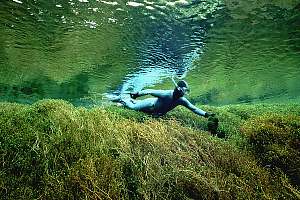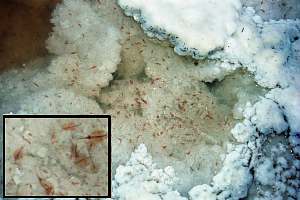| Factors |
Soil |
Land flora/fauna |
Fresh water |
Sea and ocean |
| size |
large. About 0.5-4m
deep, covering all land, where water is available some time of the year. |
large. About 0.5-40m
tall, covering all land where moisture is found but no ice. |
very small. 0.5-1000m
deep, surrounded by land. Water flows to the sea, but much evaporates.
Underground aquifers can be large but are devoid of life. |
very large. Continental
shelves 20-200m and oceans 1000-10,000m deep; average about 4000m. |
natural
fragment-
ation
(-connectivity) |
very high. Soils
are fragmented by mountains, rivers, lakes and changes in habitat, moisture,
temperature and rock type. |
high. Dissected by
freshwater rivers, tall mountain ranges and oceans. Islands. |
very high. Every
watershed is physically isolated from every other. Interconnected only
by the sea, which is a barrier to most freshwater species. |
low. All seas and
oceans are interconnected. Currents flow shallow and deep. Habitats and
regions form by temperature and depth. |
species
diversity |
very high. Due to
fragmentation. Most species unknown. In the dark no plants can live. Many
types of soil exist and interdependent guilds of species. |
very high. few phyla,
many species and guilds. Many biomes and habitats. Island speciation. Separate
continents. |
very low. Due to
small habitat, difficult living conditions, availability of water, seasons. |
low/high. Low in
productive areas and in the open ocean, due to interconnectedness. High
on the deep sea floor due to it being a stable environment. High around
islands and sea mounts. Life began in the sea. Many phyla. |
long-lived
species |
very low. The soil's
function is mainly that of breaking down, for which small species are best
suited. Small animals can creep more easily through the soil. Fungi can
grow large. Cells need to die to pass on nutrients. |
low. Many trees can
grow very old (200-2000y). Niche specialists such as orchids too. The bulk
of the species is short-lived because they are insects. Mammals and birds
5-100y. |
low. Most freshwater
species are small and live short. Sturgeons, catfish, carp, can live to
100y. Many species have adapted to aestivate in mud during the dry season. |
low/high. Productive
areas have short-lived species. Many predator fish can grow to 80y. Age
of deep sea life not known. Some phyla have no age, and could live forever,
like anemones, sponges and more. |
brood size,
offspring |
small. soil is too
compact to produce many offspring. |
small. offspring
are born near their parents, broodcare is common. |
small-medium. difficult
to answer. Some species migrate to the sea. |
very large. food
begins as very small parcels (plankton) and larvae are part of growing
these. Excessively large spawn masses to make food. |
| dispersal |
very difficult. Bacteria,
nematodes, etc. must be spread by other animals. Fungi can disperse by
wind. |
difficult. Plants
can't move and rely on special adaptations for seed dispersal. Most animals
can travel easily but large migrations uncommon. |
easy. Eggs and larvae
float suspended in the water, but currents may carry them off too quickly.
Most spawning attached to grass or under stones. Juvenile fish swim upstream. |
very easy. Eggs and
larvae float suspended in the water, dispersed easily. Mass spawning is
common. Most marine species reproduce prolificly. |
gene flow
(-genetic variability) |
low. spreading limited
by the density of soil and few organisms spread by others. |
low. gene flow limited
by how far one can walk, and by fragmentation. |
low-medium. rivers
are connected to lakes but often with barriers like waterfalls and now
also dams. |
high. eggs and juveniles
transported by currents. The young are not born near their parents. Speciation,
adaptation and evolution slow. |
| population size, effective |
very low. populations
are very local, very small. |
low. large flocks
are unusual and flocks do not mix easily. |
very low. seriously
limited by food and space. |
very large. due to
much food and much space and because populations are interconnected. |
environ-
mental
fluctuation |
low-high: moisture,
temperature. Barren soils
suffer high fluctuations but forest soils stay moist and enjoy the stability
of the forest microclimate. Soil organisms recover readily after drought.
Seasons may bring sudden leaf loss. Dry soil can become lifeless. |
high-very high: temperature,
moisture, wind, sunshine,
seasons. Land cools and warms up rapidly, especially when little moisture
is present like mountain rock, desert. Moisture is highly variable in most
places. Wind can affect growth. Seasons can cause leaf loss. |
high: rainfall,
temperature, sediment, nutrients.
The temperature of freshwater stays more constant than the land, but depends
on precipitation which is unpredictable in most places. Freshwater life
is well adapted to high variations in suspended sediment (mud) and nutrients. |
low: waves, seasons,
currents. The seas and oceans are very stable due to their water mass.
Waves affect life close to the surface. Currents may oscillate, bringing
colder or warmer water or upwellings. Sea life is not well adapted to temperature
variations, and suspended sediment (mud). |
metabolic
rate |
very high. Small
organisms have high metabolisms. They must suddenly adapt to opportunity,
a fallen leaf, a dead animal. |
low-high. Plant metabolic
rate depends very much on temperature and moisture (up to 40x). Some plants
are adapted to live slowly in difficult places. Metabolic rate of animals
varies with size and whether they are warm-blooded. Some mammals hibernate. |
low. With body temperatures
matching that of the water, animals are energy-economic, which can lead
to good growth rates (carp) and the ability to aestivate. Very few freshwater
plants. Many animals depend on other animals falling into the water. |
low-high. Some areas
in the sea have high productivity with high growth rates, such as estuaries,
the intertidal zone, coastal zone and areas with upwellings. Many slow-growing
fish have low metabolic rates, live frugally and can grow old. Plankton
organisms grow and cycle profusely. |
knowledge
of these
realms |
poor. Not only poor
knowledge of the soil species but also about how soil works. |
good. Most research
has focussed on the terrestrial world, its plants and animals. Due to the
very high number of species, large gaps in knowledge exist. Ecosystems
still poorly understood. |
fair. Freshwater
research is making good progress. Because of its poor species diversity,
knowledge about species is good; about aquatic ecosystems poor. |
poor. The sea is
difficult to get to, very large, very deep and hostile to humans. Most
fish species have been described, but the lower organisms are poorly known.
Fished species are known very well. Marine ecosystems not well understood. |
affected
by
humans |
very high. Soil organisms
are immediately affected by habitat destruction and farming or cropping,
but new communities develop. When built on or paved over, soil is lost. |
high. Habitat loss
and introduced species are the main causes of the disturbance of communities
and habitats. Over 50% of photosynthesis now used by humans. |
very high. Damming,
canalisation, habitat destruction, introduced species, development, pollution.
Almost everything humans do, negatively affects freshwater life. It is
highly threatened. Many introduced species: carp, trout, mosquitofish,
etc. |
low. Exploitation,
pollution, erosion, habitat destruction. The oceans are very large and
mix reasonably well. Human influences have a minimal effect, compared to
the other biorealms. However, the coastal zone is under threat, mainly
from exploitation and mud. The sea is the sump of civilisation. |
| extinctions |
unknown. Due to poor
species knowledge. However, when calculated from the area changed, it must
be very high. |
high. Due to human
intervention, an estimated 12% of 2-10 million species is endangered or
extinct. |
unknown/high.
Freshwater knowledge is too recent to know the losses. |
low/unknown. Most
of the ocean is unknown territory, but extinctions are deemed low due to
its interconnectedness and stability and people not living there. |
worst
human
activities |
deforestation, farming,
particularly ploughing, building, roading, reduced water cycle, desertification,
salinisation. |
habitat modification, habitat
loss, introduced species, |
soil runoff, pollution,
dams, cropping, feedlot farming, eutrophication, acid rain, aquaculture. |
exploitation, soil runoff,
pollution, human sewage, farming, cropping, aquaculture. |



